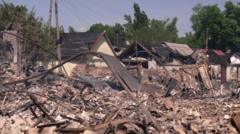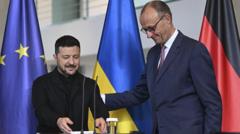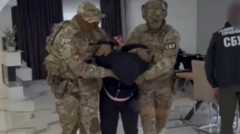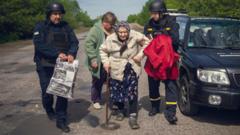The war in Ukraine is seeing a terrifying shift with the use of advanced fibre optic drones, making air assaults more lethal. As Ukrainian soldiers adapt to these new threats, the reality on the ground reveals ruined towns and rising casualties.
The Evolution of Warfare: Russia's Unmanned Threats in Ukraine

The Evolution of Warfare: Russia's Unmanned Threats in Ukraine
As Russia escalates drone warfare tactics in Ukraine, the deadly impact is felt firsthand in towns like Rodynske, altering the conflict's dynamics.
In the beleaguered town of Rodynske, Donetsk region, residents grapple with the aftermath of a devastating aerial assault. A 250 kg glide bomb recently obliterated the town’s main administrative building, and the charred remnants of residential blocks tell a grim story. Even a day after the attack, lingering smoke fills the air, and the sounds of artillery fire punctuate the tense atmosphere. The town, located 15 km (9 miles) from Pokrovsk, has been a focal point in Russia's renewed efforts to encircle and conquer the embattled city, attempting to cut off supply routes as their strategy evolves.
Amidst ongoing diplomatic failures, Russia is intensifying its military operations, marking its most significant territorial advancements in months. Our team quickly finds itself in harrowing conditions, seeking cover as Russian drones hover ominously above Rodynske. The whirring sound of these drones signals a new level of peril for the defenders, and we hear imminent explosions echoing nearby.
As Ukrainian soldiers employ desperate tactics to counter the enemy's drone threat, the situation in Rodynske highlights the dire state of warfare in Ukraine. Witnessing ghost towns turned to ruins, like Bilytske, where homes have been reduced to rubble, civilians such as 61-year-old Svitlana share heart-wrenching accounts of their losses. She notes a rapid deterioration of security: "Earlier, we could hear distant explosions...now our town is getting targeted."
In conversations with brave soldiers of the 5th Assault Brigade, the shift in military dynamics becomes clearer. They recount the oppressive nature of drone warfare, revealing that enemies can now observe combatants without risking electronic interception. A drone engineer explains, “Fibre optic drones transmit their signals through cable, making them immune to jamming.” Given this technological edge, Russian forces strategically employ these drones to scavenge and surveil even the most fortified positions.
For Ukrainian soldiers, the fear of exposure melds with the grim reality of trench warfare, where the lines between safety and danger blur. Combatants sometimes endure stints of 90 days at the front, a stark contrast to the days of yore when rotations lasted much shorter. With renewed urgency, soldiers have taken on makeshift bases far from the frontline, whispering tales of suffering, exhaustion, and fleeting moments of human connection via video calls home.
While optimistically contending with Russia's aggressive advances, Ukraine's manpower issues persist. Most soldiers, like Maksym, reluctantly swapped civilian life for military service following the conflict's escalation, facing both external threats and personal heartbreak. As warfare continues to evolve, it poses vital questions about strategy, safety, and sacrifice within this ongoing struggle.




















